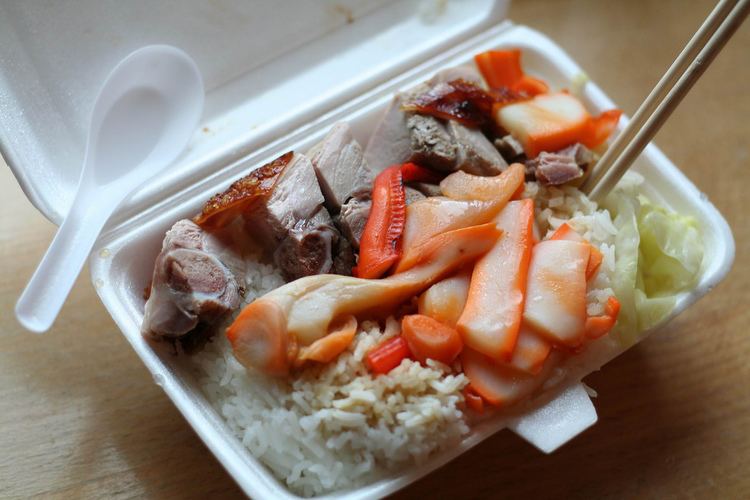 | ||
A foam food container is a disposable container for various foods, including beverages. Food types may be processed (instant noodles), raw (meat from supermarkets), or cooked (delicatessen).
Contents
The containers are commonly used to serve takeout food from restaurants, and are also available by request for diners who wish to take the remainder of their meal home.
Construction
Foam take-out containers are made from EPS foam, or another type of polystyrene foam, and produced by injecting the foam into a mold. They are usually white in color, although they may be printed or impressed with a company logo or other message.
Styrofoam is a trademark of The Dow Chemical Company for closed-cell extruded polystyrene foam currently made for thermal insulation and craft applications. The term is often incorrectly used as a generic term for expanded (not extruded) polystyrene foam, such as disposable coffee cups, coolers, or cushioning material in packaging, which are typically white and are made of expanded polystyrene beads.
This is a different material from the extruded polystyrene used for Styrofoam insulation. The polystyrene foam used for craft applications, which can be identified by its roughness and by the fact that it "crunches" when cut, is moderately soluble in many organic solvents, cyanoacrylate, and the propellants and solvents of spray paint, and is not specifically identified as expanded or extruded. Another tradename for expanded polystyrene is thermacol, originated by BASF.
Varieties
Foam takeout containers come in different varieties. These may include:
Chinese cuisine
This is the most commonly used takeout box for Chinese cuisines in East and Southeast Asia. It is standard for Cantonese cuisine in Hong Kong and many parts of China. It is sometimes used overseas in various restaurants, particularly in the United States and Canada.
Environmental issues
Because foam takeout containers are entirely made out of polystyrene foam, these containers affect the environment as they do not biodegrade easily. However, Methanogenic consortia degrade styrene, using it as a carbon source. Pseudomonas putida can also convert styrene oil into various biodegradable polyhydroxyalkanoates. Some cities have gone as far as banning the use of foam take-out containers, notably San Francisco, Seattle and Portland, Oregon. In 2013, the mayor of New York City proposed banning foam food containers, for both health and environmental reasons. This plan began to be implemented in early 2015, however a September court ruling has since put the ban on hold.
Health issues
It is debated whether styrene may migrate into food which is stored in foam food containers for even a small amount of time. Some researchers argue that polystyrene containers do pose a health risk, while industry defenders argue that trace amounts of styrene are already naturally present in food. Styrene foam containers can melt if the food or liquid is of a sufficient temperature. Some containers have been tested and labelled for safe use in microwave ovens; although the absence of such labeling does not mean a container is unsafe for this use, caution should still be taken.
Styrene is considered by both the EPA and IARC to be a possible carcinogen. It poses a health risk to workers during production of styrene and polystyrene items, with industries using a compliance program to deal with liabilities. Prolonged exposure to high amounts of styrene may affect the central nervous system, causing diseases like Parkinson's disease and multiple sclerosis.
